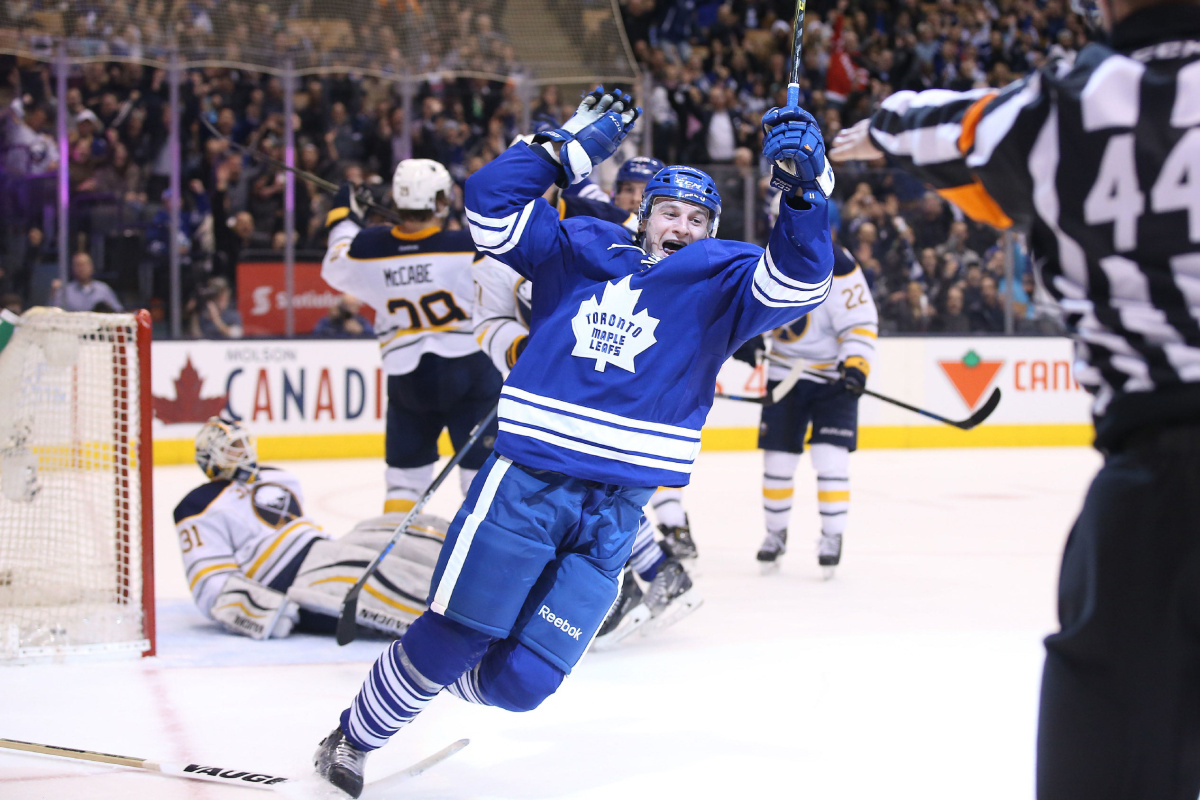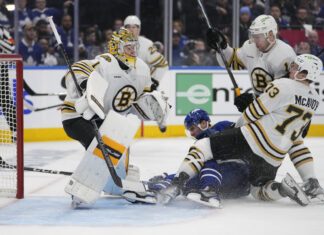With defenceman Nikita Zaitsev locked up long term, Connor Brown and Zach Hyman are the two remaining restricted free agents on the Maple Leafs’ NHL roster this offseason.
Amid a season of historic achievements for the Leafs‘ rookie crop, Mike Babcock regularly referred to Brown and Hyman as the unsung heroes on account of their day in, day out work ethic and contributions on special teams, labelling them “animals” with high-end “drive trains.”
Brown, in particular, put together a rookie campaign that would’ve generated a lot more buzz in the city of Toronto had it taken place in a normal year. Before the 2016-17 season in which all of Auston Matthews, William Nylander and Brown achieved the feat, Mikhail Grabovski was the last Leaf rookie to score 20 goals back in 2008-09; prior to Grabovski, we have to go back to Sergei Berezin in 1996-97.
Without further ado, let’s take a look at how the second contracts for the Leafs’ “older rookies” will shake out.
Zach Hyman
Hyman is a tricky case for a bunch of reasons:
- He was a 24-year-old rookie who posted 10 goals and 28 points in 2016-17.
I - He played almost exclusively on a line with Auston Matthews, a 40-goal scorer who finished second in the league behind only Sidney Crosby in goals by a centerman. With 975 of his even-strength minutes spent on Matthews’ wing, Hyman shared 90% of his 5v5 ice time with a generational talent.
I - With Matthews on the ice (5v5), Hyman posted just five goals and 18 assists over 82 games. It’s doubtful there is another example of a winger spending 90% of his time riding shotgun to a 40-goal scorer and finishing with fewer than 30 points over 82 games.
I - Hyman also finished tied for second in the NHL with four shorthanded goals while leading the entire league in shorthanded time-on-ice among forwards (2:47/game) on a top-ten penalty kill.
Let’s find a few recent comparables for a 23/24-year-old rookie who posted around 10 goals and fewer than 30 points in a contract year:
- Michael Raffl: He turned 25 in December of 2013-14, but he crossed over from Sweden that season and recorded nine goals and 22 points in 68 games. He also played a secondary PK role (1:44/game). Raffl signed for two years at a $1.1 million AAV at the end of his first NHL season.
I - William Karlsson: As a 23-year-old rookie, he posted nine goals and 20 points in 81 games in 2015-16 and played over two minutes per game on the penalty kill. He signed for two years at $1 million AAV in July 2016.
I - Melker Karlsson: The right winger posted 13 goals and 26 points in 53 games as a 24-year-old in 2014-15, with one point coming on the power play. Karlsson didn’t play a role on the PK. He signed for two years at a $1.65 million AAV.
I - Joe Colborne: He’s 6’5 and can play center, but he posted an identical stat line to Hyman as a 24-year-old rookie in 2013-14 — 10/18/28 – in 64 games, including five PP points, and received a two-year, $1.28 million AAV contract afterwards. He played a minor role (44 seconds/game) on the penalty kill.
Over the past five seasons, only two other rookies have played more than 2:30 per game on the penalty kill, and all three of those rookies played for Mike Babcock: Hyman in 2016-17, Byron Froese in 2015-16, and Luke Glendening in 2013-14.
The Red Wings signed Glendening for three years at $628,000 after he posted just seven points in 57 games in his rookie year; he later signed a four-year, $1.8 million AAV extension in July 2016. Glendening led all NHL forwards in shorthanded time-on-ice in his second season under Babcock (3:33/game), and it’s not hard to picture Hyman continuing to lead the league in that category going forward.
A similar negotiation to Hyman’s will take place this offseason with Jordan Martinook in Arizona, although Martinook is a second-year player negotiating his third NHL contract. Another recent comparable, although he was also a second-year player, is Joakim Nordstrom’s 2015-16 season as a 23-year-old. The Hurricanes forward played 1:40/game on the penalty kill and posted 10 goals and 24 points in 71 games. He’s currently halfway through a two-year, $1.275 million AAV deal, but this is his third NHL contract.
The comparison I like the most here is William Karlsson’s rookie year in 2015-16, but between Hyman’s superior production (eight more points), his four shorthanded goals and his league-leading PK TOI among NHL forwards, you have to figure he is going to come in at least a half a million higher than Karlsson’s $1 million AAV.
Hyman’s PK ability makes it easier to give him multiple years at $1.5+ million; even if/when he drops off of Matthews’ wing, he should be reliable in a shorthanded role and we know Babcock will lean on him for big minutes there. With a June 9, 1992 birthdate, a two-year deal would bridge Hyman to unrestricted free agency, so the Leafs could look at the one-year option or attempt to buy a UFA season on a three-year contract.
Connor Brown
Brown was a plug-and-play piece for the Leafs in 2016-17. The 23-year-old rookie posted solid secondary production, played in all situations, and showed an impressive level of overall maturity to his game.
The Toronto native started on the fourth line but quickly earned a promotion onto the shutdown unit with Nazem Kadri and Leo Komarov after Milan Michalek was sent to the minors in October. He also spent some time on Matthews’ right wing opposite Hyman and played on both sides of special teams (1:59 PK TOI/game, 1:13 PP TOI/game).
Brown finished the season with 20 goals and 36 points in his first NHL season, including six power play points, one shorthanded goal and three empty-net goals, as Babcock trusted him in late-game situations while protecting a lead.
If we get really specific in terms of comparables and filter the list down to 22/23-year-old rookies who were on expiring contracts and put up 15+ goals and 40 or fewer points, only two names pop up over the last six years: Chris Kreider and Brad Marchand. Marchand (21 goals, 40 points) received a two-year, $2.5 million contract under a $64.3 million cap, while Kreider (17 goals, 37 points) received a two-year, $2.48 million a year contract under a $69 million cap.
Some reasonable recent comparisons to non-rookies:
- Cody Eakin: As a 22-year-old sophomore, he put up 16 goals and 35 points in 2013-14 and received a two-year, $1.9 million AAV contract. Eakin played a similar amount to Brown on both sides of special teams.
I - Andrew Shaw: As a 22-year-old sophomore in 2013-14, he posted a 20-goal, 39-point season, including nine PP points, and received a two-year, $2 million per year contract part way through the season.
I - Brock Nelson: The Islander forward recorded 20 goals and 42 points as a 23-year-old sophomore in 2014-15 and received a three-year, $2.5 million AAV contract in September 2015. 15 of Nelson’s points came on the power play (where he played 2:42 per game) compared to just six for Brown.
I - Tomas Tatar: Not technically a rookie (he played more than six NHL games in two previous seasons), Tatar was in a similar situation as Brown in 2013-14, having played 18 NHL games the season previous as a 22-year-old. At age 23, Tatar posted a 19-goal, 39-point season in 73 games, including six power play points, and received a three-year, $2.75 million AAV contract at year’s end.
Keeping in mind that Brown posted 20 goals as a rookie and the cap is now at $73 million, he should be in the $2.5 million range on a two-year deal, or a little more on a three-year pact (26 years old in 2020, he would still be an RFA at the end of a three-year deal).
It’s worth noting that a three-year deal — if the Leafs can get Brown locked in at a good number — would make sense as it avoids syncing Brown’s third contract with Matthews and Marner’s first big paydays as well as Jake Gardiner’s first crack at unrestricted free agency. It’s not a huge deal, but it’s worth taking into account as teams generally prefer to stagger their expiring contracts as much as possible.


































